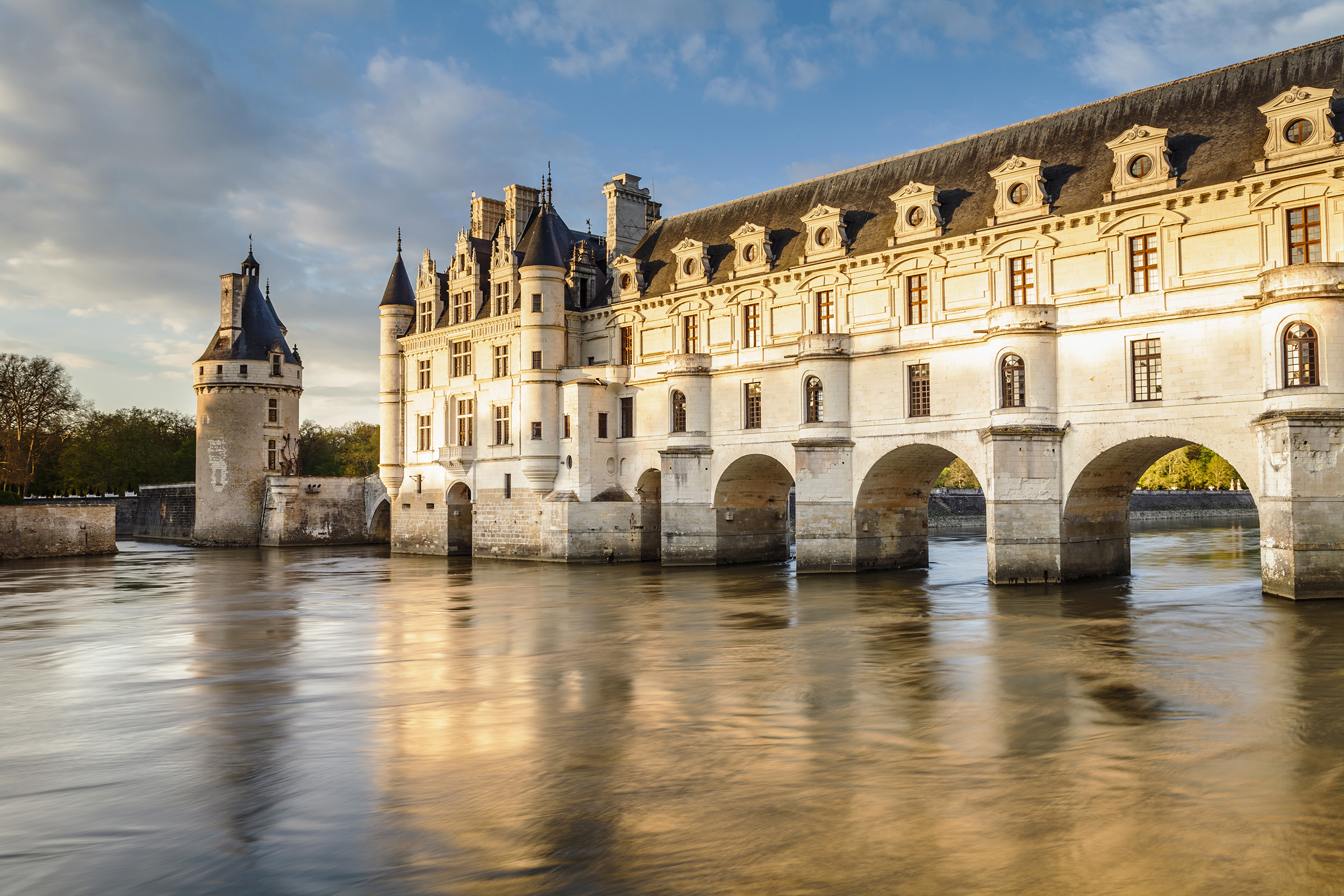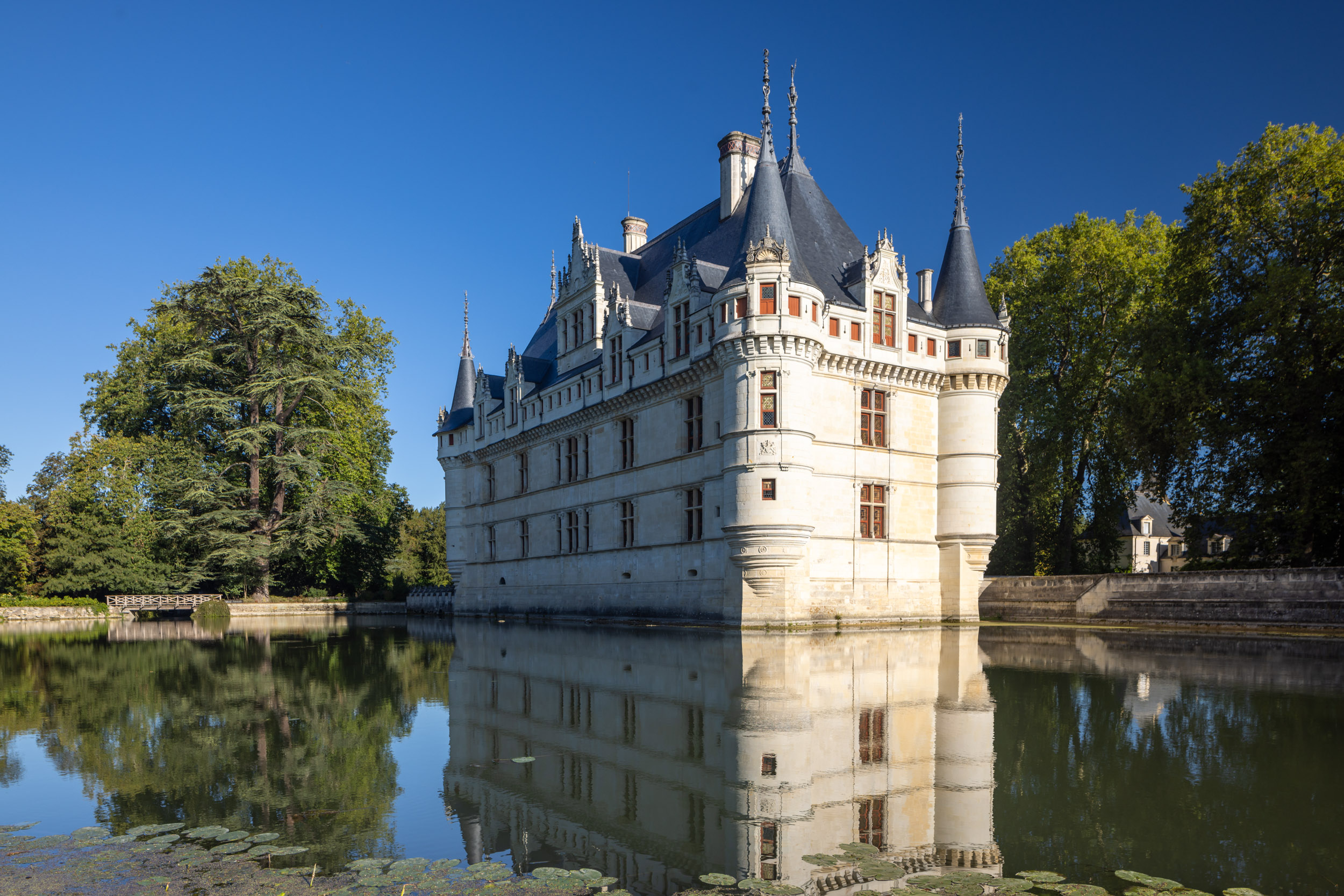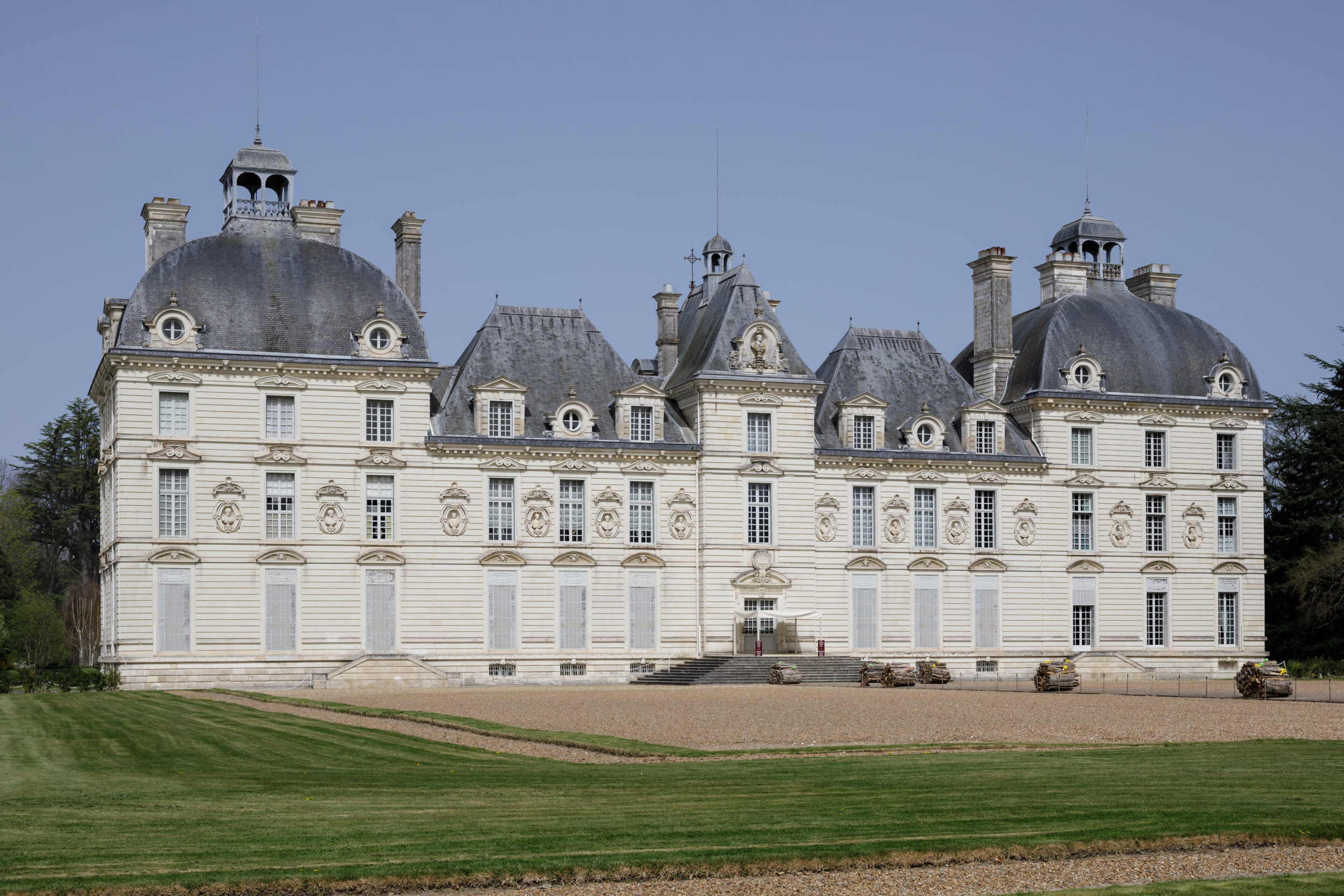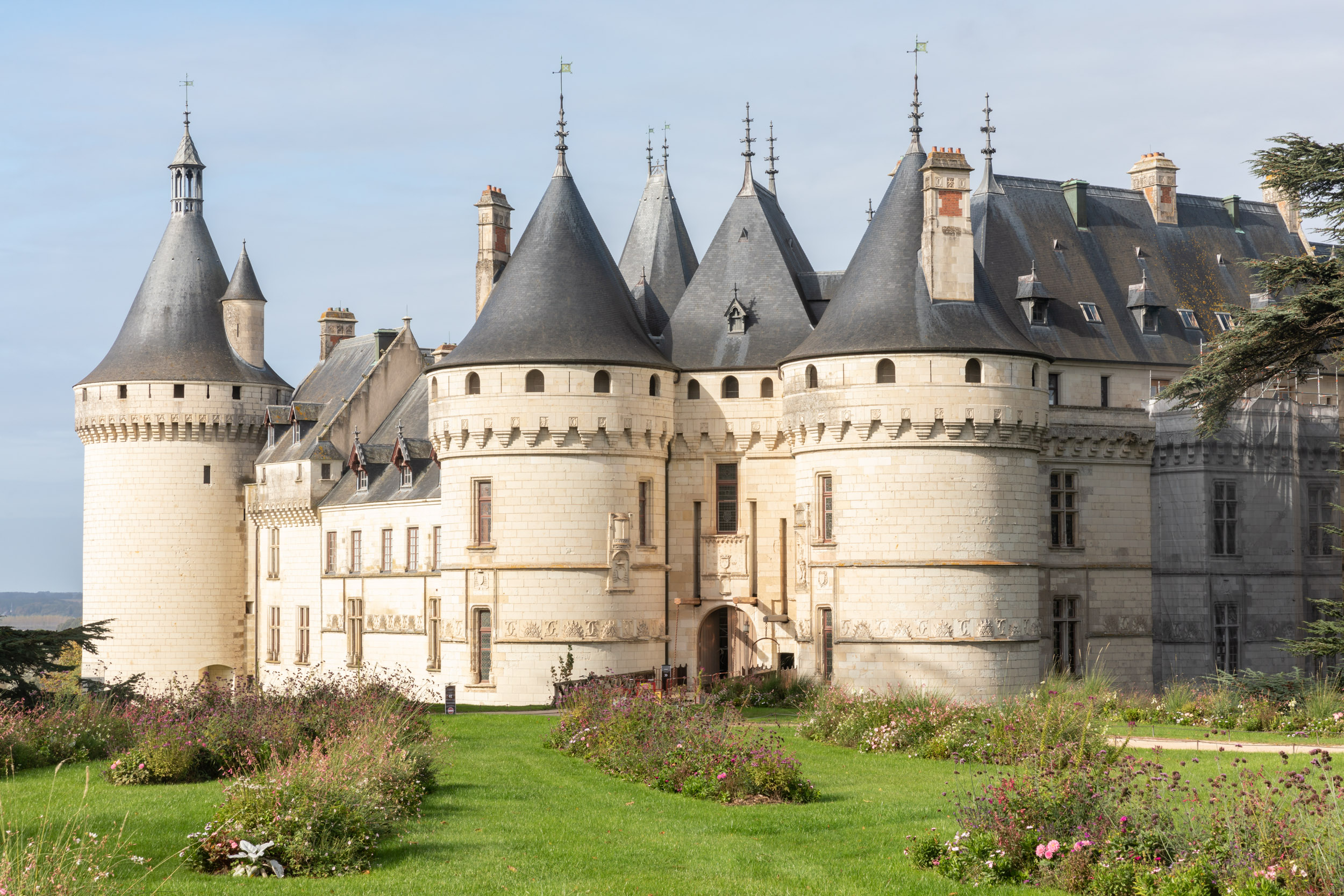
Less than 2 hours from Paris, you can discover the amazing Loire Valley châteaux. These beautiful architectural wonders are so important in the history of France that the whole area has been protected by UNESCO as an outstanding cultural landscape of great beauty.
So let’s dig into what I personally, and in no particular order, consider to be the 10 most photogenic Loire Valley chateaux.
In my own opinion, the Chateau de Chenonceau is one of the most beautiful Loire Valley chateaux. Its delicate arches spanning the river Cher offering a truly beautiful site when you first see it.
Now a private chateau, Chateau de Chenonceau is one of the most visited, other than Versailles and is in the UNESCO-protected Loire Valley. It is found in the village of Chenonceaux and is easily accessed by both car and public transportation, with a train station being within a 10-minute walk from the castle.
With its origins from at least the 11th century, the current Renaissance structure dates from the 16th century and was originally a water mill.
Château de Chenonceau features a mixture of architectural styles. The castle features both Renaissance and Gothic architecture.
There are a number of angles from which it can be photographed, either from the banks of the river Cher, in the beautiful grounds of the castle or even from a hot air balloon.
From my own personal point of view, the Chateau de Chambord is probably the granddaddy of all Loire Valley châteaux. It is considered to be one of the most recognisable castles in the world and certainly in France.
Constructed by François 1, the distinctive French Renaissance architecture is stunning no matter where you are. From the outside to the inside of the Chateau de Chambord, you will be stunned by the grandeur that this castle offers.
At one time, the chateau was abandoned after being stripped of its furniture during the French Revolution, but it saw the beginnings of restoration in the 19th century.
Chateau de Chambord was built as a hunting lodge for the King, but he barely set foot on the grounds. Today, though, the castle receives nearly a million visitors a year.
Photographing the Chateau de Chambord is an easy affair. There are many parking areas around the castle. But if you venture inside, you need to be aware that you are not allowed to use a tripod and will be asked to store it away in a locker.
Set around 10km or so west of the city of Tours, the Chateau de Villandry is simply an outstanding example of how to plant gardens.
The castle has had its fair number of owners over the centuries, but today it remains in the hands of the Carvallo family, who have owned it since 1906. Chateau de Villandry is a designated Monument Historique and, of course, a UNESCO World Heritage Site.
One of the most visited Loire Valley châteaux, as well as one of the most visited in France, visitors can wander the stunning Renaissance gardens and castle year-round.
During the summer months, there are special evenings where the castle is lit only by candlelight and having been there during one of those events, I can tell you it’s well worth a visit.
Photographing the Chateau de Villandry is best done from the inside. You can see it from the exterior but to really take advantage of it then you need to go in.
If you plan on being a regular visitor then you can buy a year-round ticket.
Considered one of the finest examples of early French Renaissance architecture among not just the Loire Valley châteaux but in France, the Château d’Azay-le-Rideau was built on a small island.
The original castle was burned to the ground, but then in the mid-16th century, the ruins were restored to what we see today.
This fine castle is open year-round to the public, and if you intend to photograph it, then you’ll have to do so without a tripod.
It’s easily accessed by public transport, either by bus or train from Tours.
Once inside, you’ll be greeted almost immediately by the imposing work of the Renaissance architect. If you read up on the full history of the castle you’ll see it’s had a colourful past and the building itself is apparently set on stilts so it didn’t sink into the mud of the Indre river.

Out of all the Loire Valley châteaux in this blog post, the Château de Blois is one of the most easily accessible of the castles. Along with the Château d’Amboise, they each sit within easy reach of a railway station and only require a short walk or local bus to get them.
The stunning Royal Château de Blois, to give it its full name, sits above the town of the same name. In the past, it was the residence of some of the French Kings, as well as being visited by Joan of Arc, who sought divine intervention there during 1429.
Architecturally, the castle features several different styles, most notably Renaissance and Gothic. So you’re definitely in for a photographic treat should you take the time to visit.
Eagle-eyed visitors are asked to look at the sculpture of the horse and his rider on the facade of Chateau de Blois. The sculpture made an error with how the horse was depicted, but I’ll leave that for your own eyes when you discover it.
As an aside, just in front of the castle sits the Maison de la Magie. This wonderful building was left to the town by the descendants of one Jean Eugène Robert-Houdin, or Houdini, for the rest of us.
Also known as Tintin’s castle, the Château de Cheverny sits in the province of Sologne and was featured in Hergé’s Adventures of Tintin as the fictional Château de Moulinsart.
Like a lot of other Loire Valley châteaux, the Château de Cheverny is privately owned as well as being classed as a Monument Historique by the French state.
This beautifully fortified castle was one of the first of the Loire Valley châteaux to open to the public for visits back in the early 20th century.
As well as the castle itself, visitors can walk around the beautiful grounds and get up close to the numerous hunting dogs that are kept in kennels near to the main building.
During April, visitors can marvel at the stunning display of tulips that are planted each year and which an additional photographic element should you visit during this time.

Sitting high above the river Loire is the famous Chateau de Chaumont-sur-Loire, which is noted for its annual garden festival from April to October.
The castle has its origins in the 10th century, but the building we see today is from the 15th century and was built on the orders of Charles I d’Amboise.
Architecturally speaking, the Chateau de Chaumont-sur-Loire features both Medieval and Renaissance architecture and has been restored and renovated many times over the years.
Today, it is owned by the French government after it was donated to the state by Marie-Charlotte Say back in the early 20th century.
If you want to photograph the castle, then you have a variety of angles from the north bank of the river Loire, and, of course, you can visit it throughout the year.
Due to its facing a more northerly direction, I would advise going in the summer if you want that beautiful golden light of sunrise or sunset on it.

The Chateau de Sully-sur-Loire is one of my personal favourite Loire Valley châteaux.
The town of Sully-sur-Loire is right on the river Loire with the castle standing just back from the banks. The town also marks the beginning of the UNESCO World Heritage Site.
The Chateau de Sully-sur-Loire is considered to be a château-fort and was built in a position where the river Loire could be forded.
The castle itself can be seen from a 360° approach, as there are footpaths and gardens from which to view it.
Throughout history, the castle has seen its fair share of events, as well as had some of its buildings and towers removed. But what remains today is a stunning piece of architecture that is well worth a visit, and certainly from a photographic view it is a stunner.
The Château d’Amboise imposes itself over the town of the same name. This royal castle has links to Leonardo da Vinci, who, it’s claimed, is buried in a chapel within the grounds.
The castle was seized by Louis XI in the 15th century, and it soon became a favourite of the Kings of France. For architecture buffs, Chateau d’Amboise features the French late Gothic Flamboyant style, which can be admired both from inside the grounds and across the mighty river Loire.
Looking across the river towards the castle offers stunning views, as, if the river is calm enough, you can have beautiful reflections in the Loire.
Getting to the Chateau d’Amboise is easy, as there is great public transport access in the form of the nearby railway station, which is served by trains going from Paris Austerlitz to Tours, Nantes or Angers.
The Château du Rivau is a stunning example of an ornamental castle and is reminiscent of a fortified castle from the 13th century.
Sat on the edge of the small village of Lémeré, the castle has been in the hands of its owners since 1992, whereby they have undertaken extensive works to ensure that the castle doesn’t fall into decay.
There is much history to Château du Rivau, and most notably towards the end of the Hundred Years’ War when Joan of Arc visited the castle with her followers to collect horses.
This stunning Loire Valley chateau is considered one of the most important historical monuments in the Touraine region and is open to the public year-round.
Photographically speaking, visitors can take images of it from the outside, but it’s inside the castle grounds where it really shines.
Château du Riveau features beautiful gardens on the grounds, and also, peacocks roam around, adding another photographic element.
Accessing the castle is best done by car as it is quite far from the main transportation hubs.
If you’re looking into a day trip to the Loire Valley châteaux from Paris, then there are a variety of ways to get to them.
Take the train either from Gare Montparnasse or Gare Austerlitz will get you right to many of the Chateaux of the Loire. Montparnasse is served by the high-speed TGV train and takes about an hour and fifteen minutes journey time, whereas, from Austerlitz, you are looking at around two hours or so as you take the slower intercity trains.
From Gare Montparnasse, you travel either to Tours or onwards to Nantes. If you’re looking at going eastwards, you’ll have to get a regional train or an intercity.
From Gare Austerlitz, you’ll pass by or be within reach of a number of Loire Valley châteaux, including Chambord, Blois, Chaumont-sur-Loire and Amboise.
Buying train tickets from Paris to the Loire Valley can either be done at the railway station or online.
If you’re planning on flying into France the heading straight down to the Loire Valley, then there are a number of high-speed TGV trains from the airport to Saint Pierre des Corps, which is near the city of Tours.
From here, you’ll either have to hire a car or get an intercity or regional train, depending on which castle you want to visit.
The city of Tours has its own airport, which is served by the budget airline Ryanair. This will take you right into the heart of the Loire Valley, and from there you either hire a car at the airport or use public transport.
Hire cars are available at the airport from the usual operators, or you can walk for 10 minutes or so and get a tram into the city centre, where it stops just outside the railway station. From there, you’ll be looking at either a regional train or an intercity, depending on which castle you want to visit.
Every year at the end of May, I run Loire Valley photography tours where you can have your own opportunity to learn from me and get to capture a number of the Loire Valley châteaux.
If you’re interested in joining me, then check out the dedicated web page.
My YouTube channel also has a number of vlogs on the Loire Valley, where you see some of how I capture the famous châteaux.